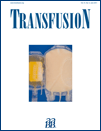Male-only fresh-frozen plasma for transfusion-related acute lung injury prevention: before-and-after comparative cohort study
Data were collected and assessed by or under the supervision of JCW-O, EAB, AvT, PZ, and MRS; AB also assessed the reports. The analysis was designed and performed by RAM, JCW-O, and JGvdB. JCW-O drafted the article and is the guarantor. All authors critically reviewed the article, agreed to the decision to submit it for publication and had access to the data.
Abstract
BACKGROUND: Transfusion-related acute lung injury (TRALI) is one of the most serious complications of blood transfusion. It can be caused by incompatible white blood cell antibodies in transfused plasma. The objective of this study was to quantify the reduction of TRALI after introduction of male-only plasma for transfusion as a preventive measure, which took effect in 2007.
STUDY DESIGN AND METHODS: In the Netherlands all cases of TRALI are reported to the national hemovigilance office. All reported cases of TRALI from 2002 to November 2009 were considered for inclusion. Those meeting the Canadian consensus clinical definition were included and subdivided according to whether or not the patient had received quarantine fresh-frozen plasma (Q-FFP) in the 6-hour period before the reaction. The numbers of TRALI cases involving plasma donated before the measure and of those involving plasma donated after the measure were compared to TRALI cases that did not involve Q-FFP to adjust for reporting bias.
RESULTS: A total of 110 cases were included in the analysis. Of 68 cases before the measure, 36 involved Q-FFP. Thirty-one cases occurred after the measure of which eight involved Q-FFP. Eleven occurred in the transitional period, of which four involved Q-FFP. The population-attributable risk of premeasure plasma among TRALI cases occurring before the measure was 0.33 (95% confidence interval, 0.09-0.51).
CONCLUSIONS: In the Netherlands the male-only Q-FFP measure was associated with a 33% reduction of TRALI cases.




